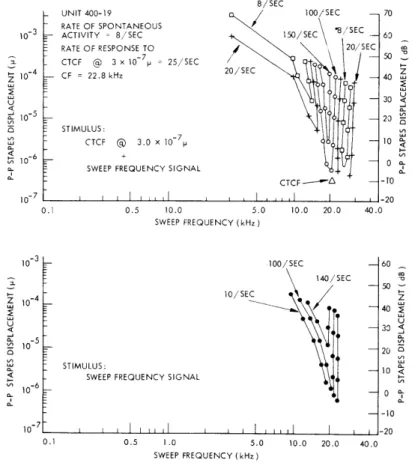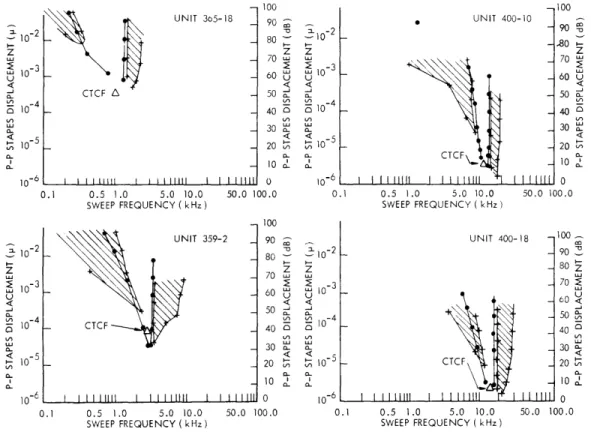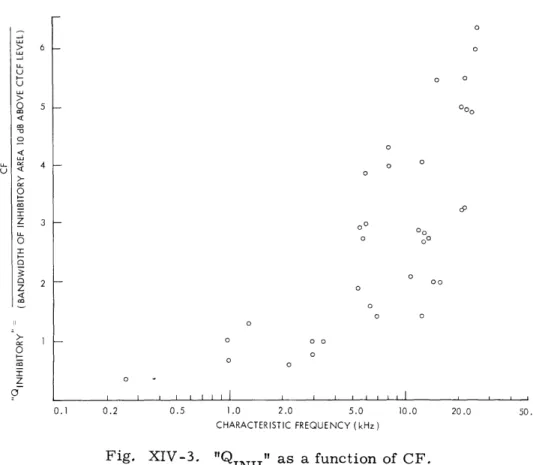Academic and Research Staff
Prof. D. B. Geselowitzt Prof. T. F. Weiss$ Dr. M. Nomoto*** Prof. P. R. Gray Dr. J. S. Barlow t Dr. R. R. Pfeiffer$ Prof. H. B. Lee Dr. A. W. B. Cunningham Dr. R. Rojas-Corona Prof. W. T. Peake$ N. I. Durlach Dr. G. F. Songster Prof. W. A. Rosenblith Dr. H. FischlerIt R. M. Brown$ Prof. W. M. Siebert Dr. R. D. Hall A. H. Crist$ Prof. R. Suzuki** Dr. N. Y. S. KiangJ D. P. Langbeint
Graduate Students
J. A. Anderson R. E. Greenwood E. C. Moxon G. von Bismarck J. J. Guinan, Jr. M. Nahvi L. D. Braida D. K. Hartline P. H. O'Lague S. K. Burns L. K. Krakauer D. J-M. Poussart
H. S. Colburn R. G. Mark M. B. Sachs
J. E. Evans E. G. Merrill I. H. Thomae
J. A. Freeman P. J. Metz III M. L. Wiederhold D. C. Milne
A. AUDITORY NERVE FIBER RESPONSES TO TWO-TONE STIMULI
[This report gives a brief summary of a Ph.D. thesis of the same title, submitted to the Department of Electrical Engineering, M.I.T., August 1966. Further details and results may be found in the thesis itself.]
Electrophysiological investigations of auditory nerve fiber responses thus far have been limited largely to what have been called "simple" acoustic stimuli: clicks, tones, and tone bursts. Some recent findingsl' 2 have revealed rather complicated interactions in the responses to more complex stimuli and have indicated that extension of results from simple to complex stimuli may not be straightforward. There have been few
rThis work was supported by the National Institutes of Health (Grant 2 PO1 MH-04737-06), the Joint Services Electronics Programs (U.S. Army, U.S. Navy, and U.S. Air Force) under Contract DA 36-039-AMC-03200(E), the National Science Founda-tion (Grant GK-835), and the NaFounda-tional Aeronautics and Space AdministraFounda-tion (Grant NsG-496).
T
Visiting Associate Professor from the Moore School, University of Pennsylvania. Also at Eaton-Peabody Laboratory, Massachusetts Eye and Ear Infirmary, Boston, Massachusetts.
Visiting Assistant Professor from the Research Institute of Dental Materials, Tokyo Medical and Dental University, Tokyo, Japan.
ttResearch Affiliate in Communication Sciences from the Neurophysiological Labo-ratory of the Neurology Service of the Massachusetts General Hospital, Boston, Massa-chusetts.
UFrom the Department of Electronics, Weizmann Institute of Science, Rehovoth, Israel.
***Public Health Service International Postdoctoral Research Fellow from the Department of Physiology, Tokyo Medical and Dental University, Tokyo, Japan.
quantitative data relating to these interactions, however. In this study we have attempted to describe quantitatively the responses of auditory nerve fibers to somewhat more
com-plex stimuli, sums of two tones. We have chosen to describe the fiber responses by a single variable, rate of spike discharge.
We have used a sweep-frequency technique3
to construct iso-rate contours for responses to one- and two-tone stimuli. An iso-rate contour is the locus of points in the frequency-level plane corresponding to stimuli that evoke a specified rate of response from a fiber. Such contours provide a convenient means for illustrating general charac-teristics of the dependence of rate on stimulus frequency and level. When measuring rate as a function of the frequency of one of two tones, we presented that tone as a sweep-frequency signal. If a second tone was present, it was presented as a continuous tone at the fiber's characteristic frequency (CTCF). Figure XIV-1 shows iso-rate contours for a typical fiber for both one- and two-tone stimuli. In this figure we. have specified stim-ulus levels in terms of peak-to-peak stapes displacement. In doing so, we hope to iso-late effects produced by the cochlea from effects produced by the frequency dependence
4 of the middle-ear transmission.
8/SEC
UNIT 400-19 / 100/SEC - 70
RATE OF SPONTANEOUS
10- 3 ACTIVITY = 8/ SEC 1 EC *8SEC 6
RATE OF RESPONSE TO 20/EC
CTCF @ 3 x 10-7 = 25/SEC 50 10- 4 - CF = 22.8 kHz 20/SEC 40 30 V -5 10 20 S STIMULUS: CTCF ® 3.0 x 10 10 - 6 106 -0
SWEEP FREQUENCY SIGNAL 0
CTCF I-- ' - " 1-TO 10- 7 I I | ,I , , I I -20 0.1 0.5 10.0 5.0 10.0 20.0 40.0 SWEEP FREQUENCY (kHz) 10- 3 100/SEC -- 60 140/SEC S -4 10/SEC - 50 - 5 10 -20 STIMULUS: - 10
SWEEP FREQUENCY SIGNAL
1-6 - 0 10 0ci - -10 -7 10- 7 I l -20 0.1 0.5 1.0 5.0 10.0 20.0 40.0 SWEEP FREQUENCY ( kHz)
For one-tone stimuli (lower portion of Fig. XIV-1) we find a limited region in the stimulus plane within which a fiber's rate of discharge is increased above its spontane-ous level. For each fiber the "excitatory response area" is defined to be that area in the stimulus plane bounded below by the iso-rate contour corresponding to a rate 20 per cent greater than the spontaneous rate. From Fig. XIV-1 it is evident that all stimuli lying within a fiber's excitatory response area evoke a rate of response at least 20 per cent above the spontaneous rate.
In the two-tone stimulus situation (CTCF plus sweep-frequency signal - upper section of Fig. XIV-1) the fiber exhibits a region in the sweep-frequency stimulus plane in which the effect of the sweep-frequency signal is to increase the rate of discharge above its value for the CTCF presented alone. To the right and left of this region are regions in which the effect of the sweep-frequency signal is to reduce the rate below its value for the CTCF alone. For any CTCF level, we define the "inhibitory response area" to be the region in the sweep-frequency stimulus plane bounded below by the iso-rate con-tours corresponding to a rate equal to 80 per cent of the rate to the CTCF alone. Any tone with stimulus parameters within the inhibitory response area causes a reduction in the rate of response to the CTCF of at least 20 per cent. We call the reduction in the
- 100 -100 ~10- 2 - 80 10-2 - - 80 Z Z Z Z - 70 L w 70 10 60 10-3 60 CTCF L - 50 E50 -10 - 400 0 10 40 30 0 30 C -5 < 5 10-5 - 20 10- - 20
10- 6 I I llit I I Ill I I 1 IIl 0 10-6 I I 111111 I I I 11111 I l l
lli
00.1 0.5 1.0 5.0 10.0 50.0 100.0 0.1 0.5 1.0 5.0 10.0 50.0 100.0
SWEEP FREQUENCY ( kHz) SWEEP FREQUENCY ( kHz)
100 UNIT 359-2 _ 90 UNIT 400-18 -100 i-2 80 1-2 - 90 % zU - 70 W z 80 0 -3 -3 - 70 _450 i - 4 50 U 10 CTCF 0 - 10 0 <30 30 U " "31-. 10- 5 2T0 10- 5 20 - 0 ' -10
10-6 I 11 11111 I I111111 I I 11111 0 10-6 I I Illll I IIIII 011111 0
0.1 0.5 1.0 5.0 10.0 50.0 100.0 0.1 0.5 1.0 5.0 10.0 50.0 100.0
SWEEP FREQUENCY (kHz) SWEEP FREQUENCY (kHz)
fiber's rate of discharge to a CTCF by the presentation of a second tone "two-tone inhi-bition." All second tones with stimulus parameters within the inhibitory response area produce two-tone inhibition. We have observed two-tone inhibition for more than 300 fibers; we have never failed to find two-tone inhibition for any fiber when we were able to look for it systematically.
Figure XIV-2 shows excitatory and inhibitory response areas for four fibers covering a broad range of characteristic frequencies. These areas are typical of more than 200 fibers. The fibers all have inhibitory areas on both sides of their excitatory response areas. We have found that the extent of the inhibitory areas depends on the level of CTCF employed. An increase in CTCF level causes an upward shift in the boundaries of the inhibitory areas in the sweep-frequency stimulus plane. As is illustrated by Unit 359-2 (Fig. XIV-2), if the level of the CTCF is low enough, the inhibitory area above the CF extends down to levels very close to the tip of the excitatory response area. Higher levels are needed, however, to produce two-tone inhibition at frequencies below fiber CF. The minimum levels necessary to reduce rate by a given amount at frequencies below the CF are at least 20 dB greater than the minimum levels of stapes displacement needed at frequencies above the CF.
0 0 o 00oo 00 I I I I I I I 0.1 0.2 0.5 1.0 2.0 5.0 CHARACTERISTIC FREQUENCY (kHz) 10.0 20.0 50.0
Fig. XIV-3. "Q INH" as a function of CF.
INH
I I I I I I I , IAn appropriately defined "Q" can be taken as a measure of the extent of the inhib-itory areas in the sweep-frequency stimulus frequency dimension. We have adopted the following definition of the "Q" of an inhibitory area: QINH = CF/bandwidth of the inhibitory area 10 dB above the CTCF level. Figure XIV-3 shows a scatter plot of QINH versus fiber CF for 35 fibers. The dependence of these inhibitory Q's on CF is similar to the dependence of the tuning curve Q's given by Kiang,1 in that both the tuning curve Q's and inhibitory Q's are roughly constant for CF below 2 kHz, and for higher frequen-cies both Q's increase with increasing CF.
In order to collect data with which we could test mathematical descriptions of the two-responses, we used tone-burst stimuli and measured the discharge rate after the
tran-sient at the tone-burst onset. Using this method, we developed the following expression to describe the relationship between discharge rate and the stimulus parameters of the two-tones. (Our data are restricted to the case in which one tone is at fiber CF.)
r(PCF C' P2'f 2) = RSP + R(PCF fC
) f) + R(P'f2) g CF f '
where
r(PCF' C' P2 f2) = spike discharge rate as a function of the two-tone stimulus parameters
PCF = sound-pressure level of the tone at the characteristic frequency f = characteristic frequency
P2 = sound-pressure level of the second tone f2 = frequency of the second tone
RSP = r(O, fC 0, f ) = spontaneous discharge rate
R(PCF' fC) = r(PCF' fC' 0, f2) - RSP = "driven part" of the rate to one tone alone
g C fC f) = "inhibitory multiplier. "
The function R(P, f) is a monotone nondecreasing function of P. The inhibitory multi-plier g ( fC 2 is 1 for a small value of P2/PCF and is a monotone decreasing
function of P2/PCF. This mathematical form has been adequate to "fit" all data that we have obtained, although we lack sufficient data for certain conditions. We have sug-gested how this result might be extended to more general two-tone stimuli (neither tone at the CF) and to the sum of an arbitrary number of tones.


